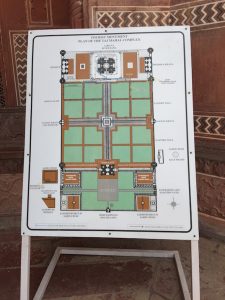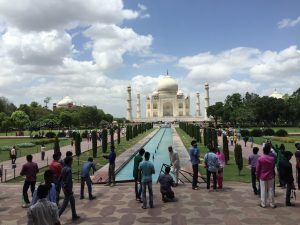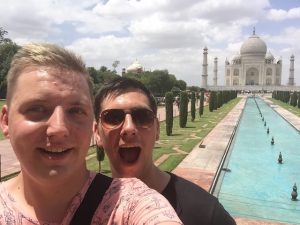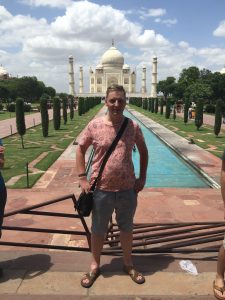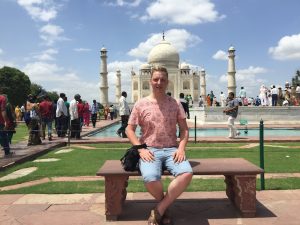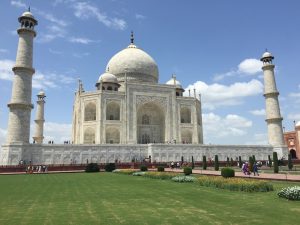| The Taj Mahal is one of the seven Wonders of the World, so being in India I had to see it. I went with Robert, Neha and Neha’s family. The journey by car from Delhi to the Taj Mahal is about 3-4 hours one way, but is totally worth it.
All cars have been banned within a certain distance of the Taj Mahal because of fears that the air pollution might stain or damage the famous white marble building. To get to the Taj Mahal you are required to take an electric buggy. Before the Taj Mahal there is a gatehouse where you buy tickets. For foreigners the admission fee is currently ₹750 (about £7.50), although Indian citizens get admission much cheaper. Through an archway you get your first glance at the Taj Mahal. You see it’s lush green gardens with it’s turquoise water fountains. There still some distance away you see the architecturally beautiful, ginormous and symmetrical feat that is the Taj Mahal. |
There was no photography allowed on the inside of the Taj Mahal. However outside the Taj Mahal photos were allowed. The Taj Mahal is difficult to describe in words, so here are some of the many of photos taken:
The Taj Mahal was built by an Emperor as a mausoleum for his third and favourite and after she died during childbirth. He designed everything to look symmetrical from a distance. It was said to be incredibly expensive to build at the time and is considered priceless now.
As you get close to the Taj Mahal you realise that the four towers are actually titled outwards. This for two reasons. Firstly to give the impression from a distance that they stand straight. Secondly so that if there was an earth quake the towers would fall outwards not inwards onto the main structure.
Behind the Taj Mahal is a river. On the opposite side riverbank the Emperor wanted to build a black Taj Mahal as a mausoleum for himself. This would have continued his love of symmetry and created a mirror image. However a year into it’s construction he was taken ill and died before it could be completed.
One of his wives negotiated and got his ashes buried in the Taj Mahal, with his favourite wife. The joint burial tombs are ironically the only thing in the Taj Mahal that isn’t symmetrical.
I recommend that if you’re planning to visit the Taj Mahal or any other tourist attraction in India that you read up on them before you go.
I never post photos of people without their permission. For this reason photos of Neha’s family have been deliberately excluded as I didn’t get time to ask each family member for their permission to post photos of themselves here.
The next blog post of the series titled My India Adventure (Part 7) – Agra Fort will be coming soon. So keep checking back for updates.
Write soon,
Antony


